Phillies Shortstop Bryson Stott Continues to Grow During First Career Playoff Push

Bryson Stott is hoping to be the starting shortstop for a postseason team.
Not so long ago, that would have seemed a tad far-fetched. The 24-year-old top prospect had no regular position, no clear path to playing time, and the Philadelphia Phillies were stumbling towards another mediocre season.
Now, it appears to be a likely outcome. Stott is the everyday shortstop. He has been one of the best rookies in baseball since the All-Star break. The Phillies are inching closer and closer to their first postseason berth in 11 years, and their young shortstop's breakout is one of the major reasons why. A lot has changed in just a few short months.
Indeed, one of the most impressive skills Stott has demonstrated this year is an ability to change. He has shown so much growth since the beginning of the season, and his willingness to learn and adapt has been essential to his success.
Stott began the year hitting just .133 in his first nine games. He then rode the bench for a week, not getting a single at-bat for several straight games, before he was eventually demoted to Lehigh Valley. His bat was a liability for a Phillies team with postseason aspirations, so the club decided he was better served getting regular playing time with the IronPigs.
Bryson Stott goes big fly for the @IronPigs.
— MLB Pipeline (@MLBPipeline) May 6, 2022
The top @Phillies prospect now has back-to-back multihit games: pic.twitter.com/5U46B62aHd
At Triple-A, however, Stott hit too well to be ignored, slashing .333/.375/.611 with two home runs in nine games. It quickly became clear the minors had nothing more to offer him. When Didi Gregorius landed on the IL with a left knee sprain, Stott was called back up to the big leagues, where he has remained ever since.
Back in Philadelphia, unfortunately, his struggles resumed. Through May, Stott hit .116 with a .331 OPS. It was another disastrous month, but this time, there was no demotion looming. This was where Stott needed to be. He had done all he could against minor league pitching, and now he needed time to develop his swing in the show.
The Phillies took a gamble giving Stott so much playing time despite his atrocious slash line, especially since the rest of the lineup was struggling too. Philadelphia finished May with a 10-18 record, seven games back of a Wild Card spot. They needed every advantage they could get, and Stott wasn't doing the team any favors.
Yet the Phillies were smart to have faith in their former first-round draft pick. Because while Stott was still struggling, he was also starting to show signs of development. He wasn't getting the desired results quite yet, but his plate discipline was steadily improving.
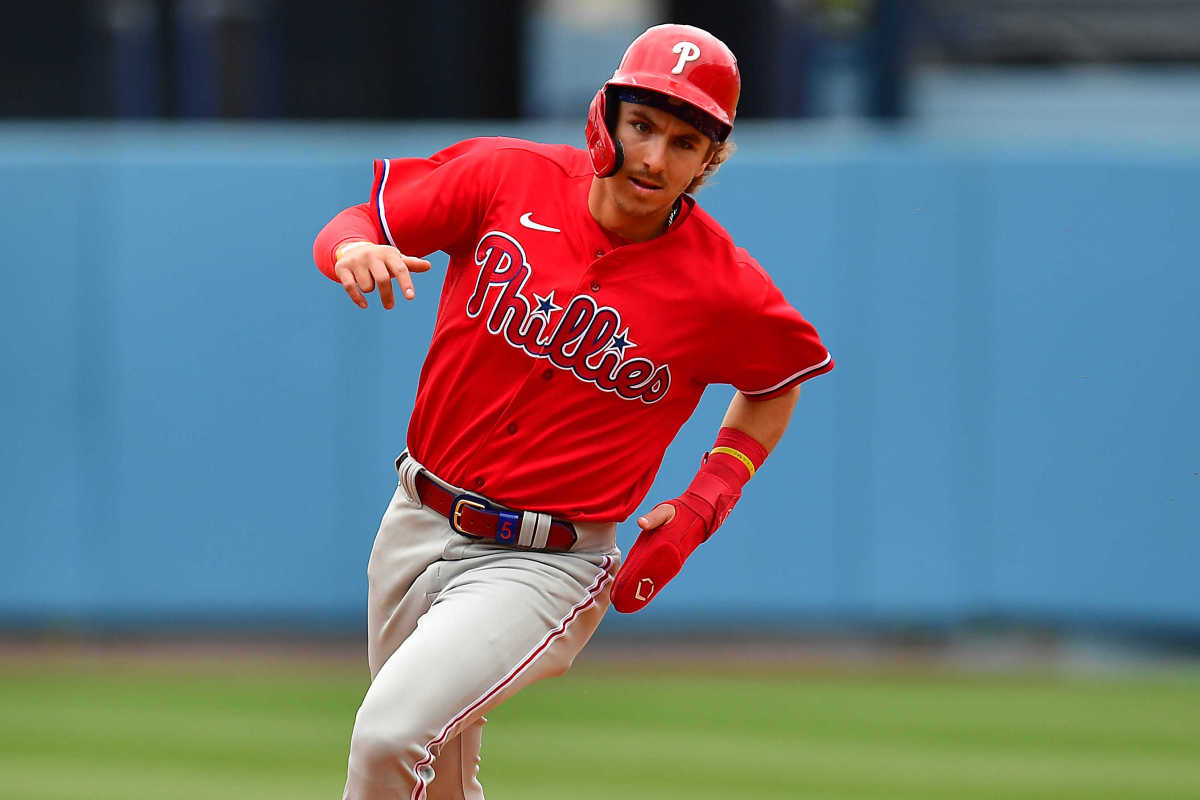
After his call-up, Stott's walk rate more than doubled, from 3.2% in April to 8.5% in May. He started swinging at fewer pitches outside the strike zone and more pitches inside the strike zone. As a result, his overall swing rate stayed the same, but his contact rate blossomed. He was whiffing less and putting more balls in play. Stott was becoming a better hitter, and sooner or later, it was going to pay off.
Lo and behold, as the calendar turned to June, Stott's new and improved approach at the plate began to show tangible results. Throughout the next six weeks (Jun. 1 to Jul. 12) he grew into a capable big league hitter. No one would say his stats were outstanding (.222 AVG, .668 OPS), but compared to his performance in April and May, his numbers represented a miraculous improvement. Stott wasn't an offensive asset quite yet, but he was no longer a gaping hole at the bottom of the lineup.
As the year went on, the shortstop continued to refine his approach. During the next month of games (Jul. 13 to Aug. 12), Stott really and truly broke out. He batted an even .300 with an .824 OPS and 129 wRC+. Over the course of just a few months, he went from looking utterly lost at the plate to looking right at home in a lineup full of veteran sluggers.
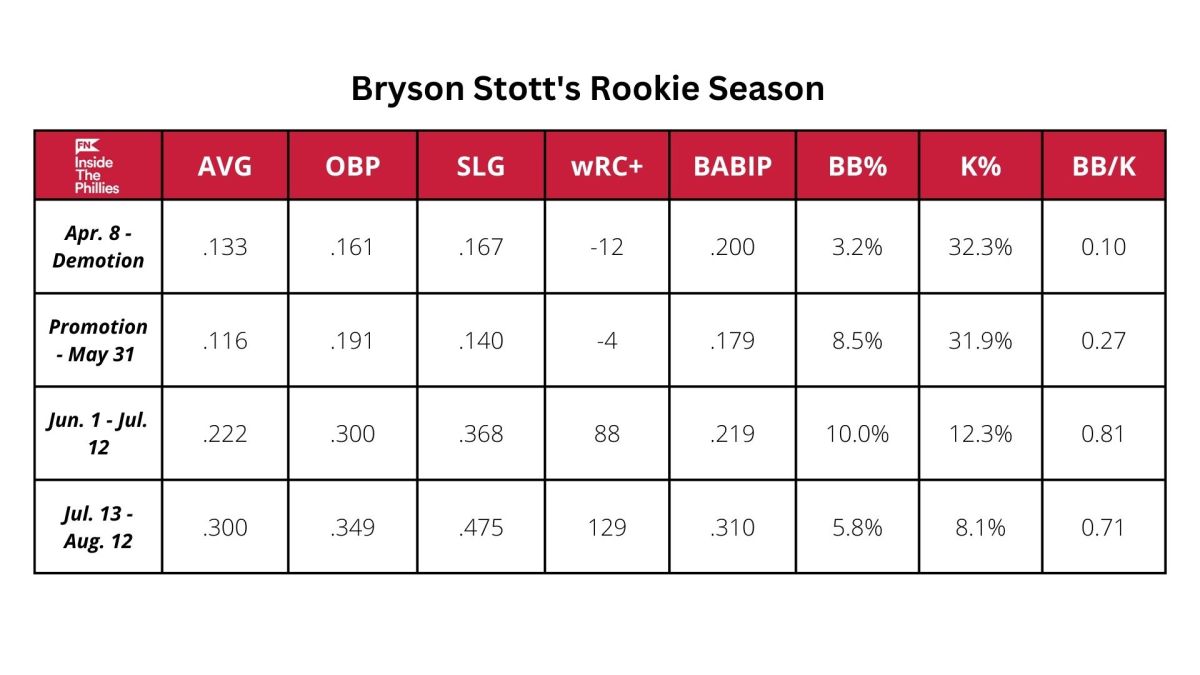
Even better, Stott's underlying numbers continued to show promising signs of development. In that stretch, he posted the lowest strikeout rate in the National League. He also had the highest contact rate (an absolutely unbelievable 95.3%) and the lowest swinging strike rate (a microscopic 2.2%) in all of baseball.
It was a thrilling month for Stott, and it was an excellent indication of all the progress he had made. What happened next, however, would be equally important. After all, it was highly unlikely Stott could maintain such elite plate discipline numbers over a longer period of time. He needed to prove he could be a solid big league hitter without a 95% contact rate.
And so, we finally reach the most recent month's worth of games. As suspected, opposing pitchers began to adjust their approach towards Stott, and his plate discipline started to waver.
When Stott looked helpless at the plate in the early going this season, pitchers were pounding the strike zone against him. But once it became clear he was a contact machine, his opponents realized they could no throw him so many strikes.
Thus, as the season has gone on, Stott has been seeing fewer and fewer pitches in the strike zone (as represented by the blue line on the graph below). To compensate, he has recently started swinging at significantly more pitches outside the zone (as the red line shows).
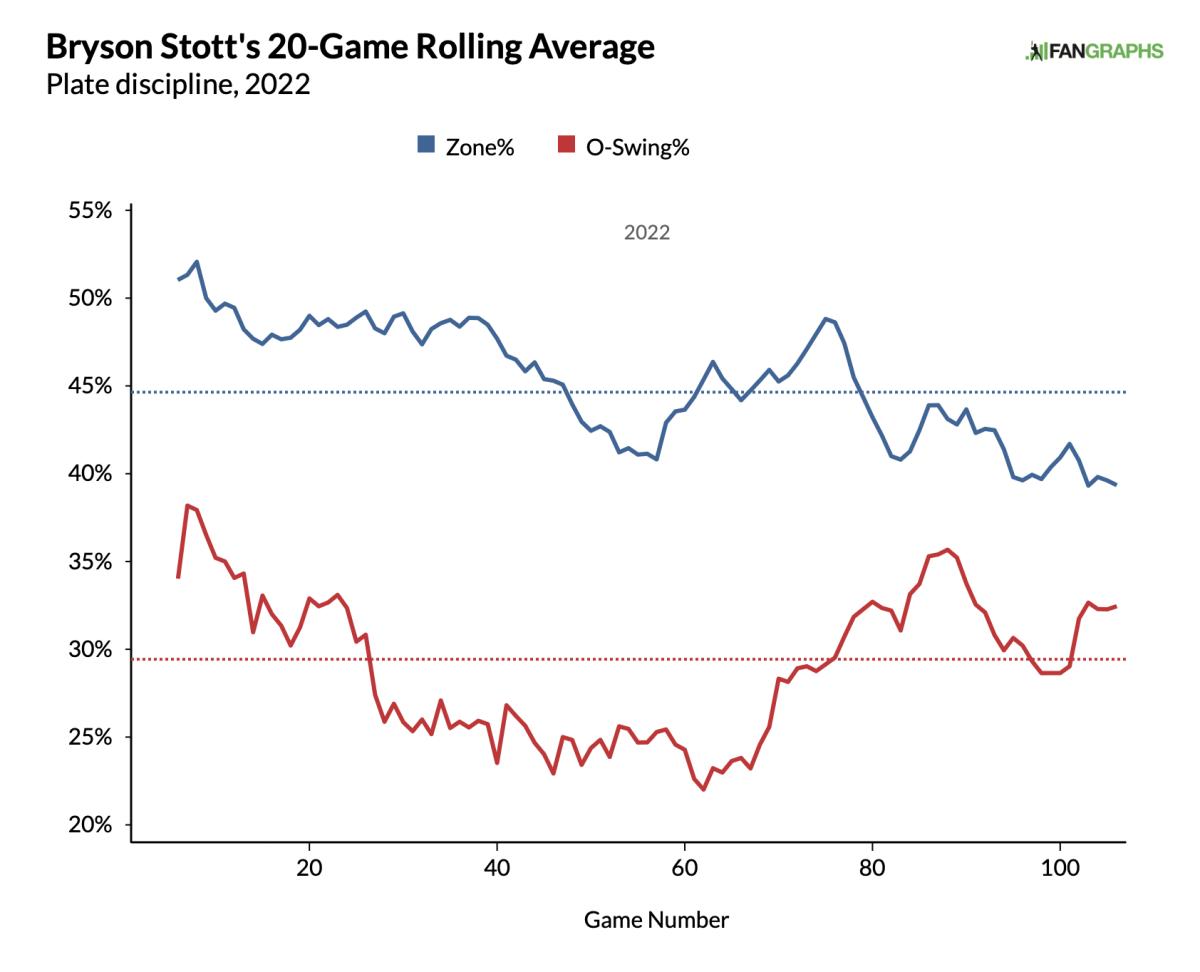
Typically, pitches outside the strike zone are going to be harder to hit. So, it isn't too surprising that as Stott swings at more pitches outside the zone, he is whiffing more often and therefore making less contact.
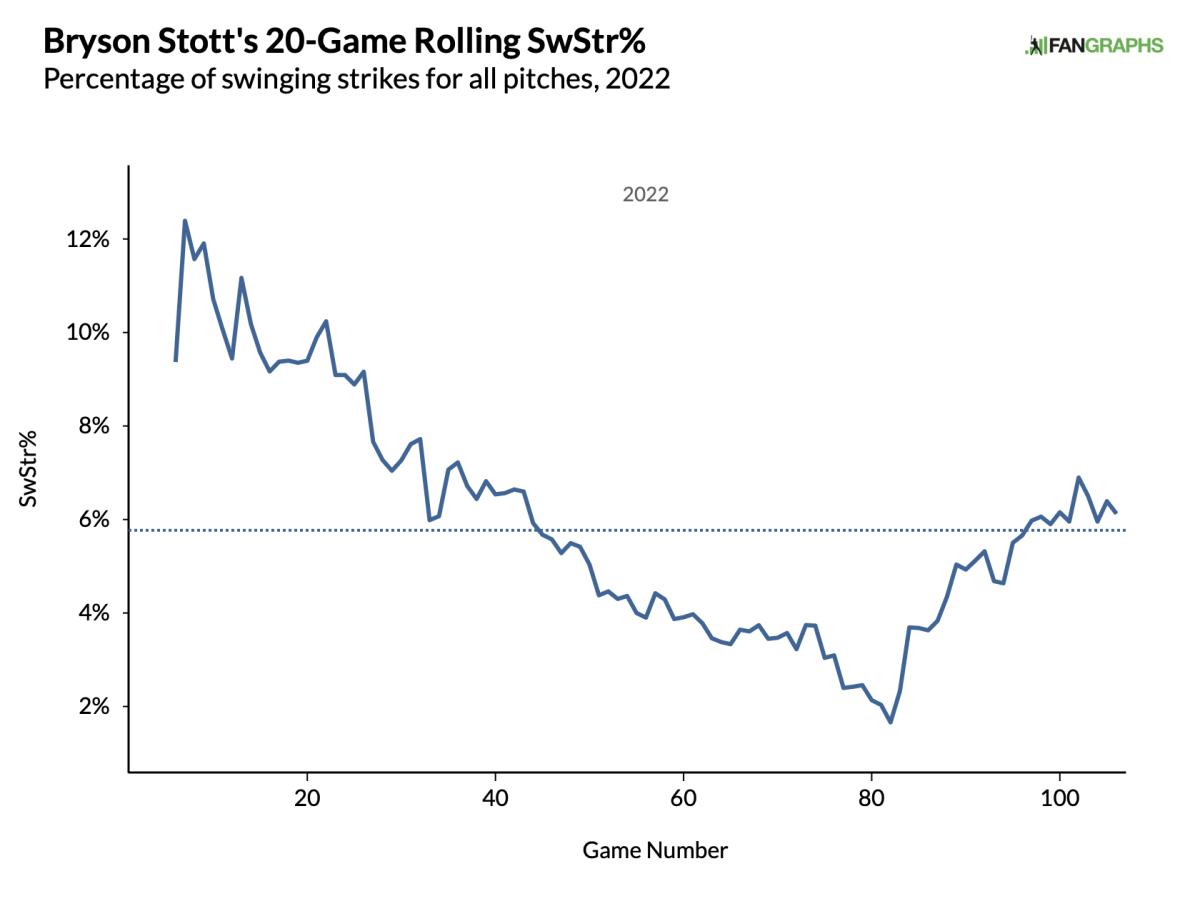
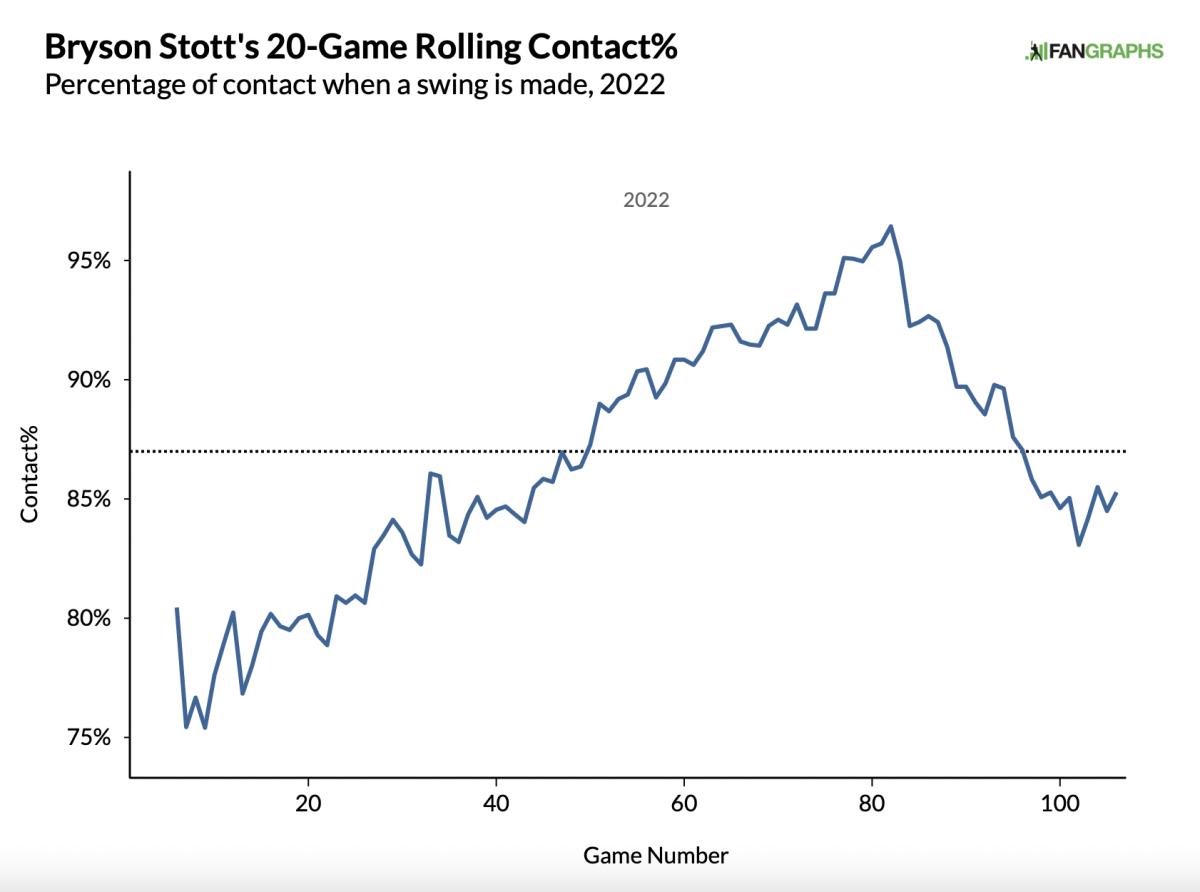
Consequently, Stott has also been striking out far more. That's particularly worrying for a player who was thriving in large part thanks to an extra-low strikeout rate.
- Jun. 1 to Jul. 12: 12.3% strikeout rate
- Jul. 13 to Aug. 12: 8.1% strikeout rate
- Aug. 13 to Sept. 12: 21.5% strikeout rate
Thankfully, while these trends might look like signs of a serious problem – striking out is rarely a good thing – it's not nearly as bad as it seems.
The chances of Stott maintaining such an elite contact rate were always going to be slim. What we're seeing here is the natural progression of a young player in Major League Baseball: he makes adjustments, so his opponents make adjustments, and so he adjusts all over again.
Stott's plate discipline stats are still good, even if they are no longer the best of the best. His BB% and K% over the past month are right around league average, and his contact rate is still quite high.
Even better, the contact that Stott is making, though lesser in quantity, has been greater in quality. He is hitting more line drives (the kind of batted ball most likely to result in a hit) and fewer fly balls (the kind of batted ball least likely result in a hit).
He is also pulling the ball more than he was earlier in the season, and that has helped him to maintain a higher batting average on balls in play (BABIP) and, therefore, a higher batting average.
Over the past month, Stott is hitting .279 with a 113 wRC+. He ranks fifth among NL shortstops in batting average, third in on-base percentage, and sixth in slugging. In other words, he has continued to be a productive offensive player – he's just doing so with a slightly different approach.
Opposing pitchers caught on to Stott's tactics and recalibrated in response. Many a less talented hitter would have crumbled under such circumstances, but Stott smoothly and calmly reworked his own approach instead.
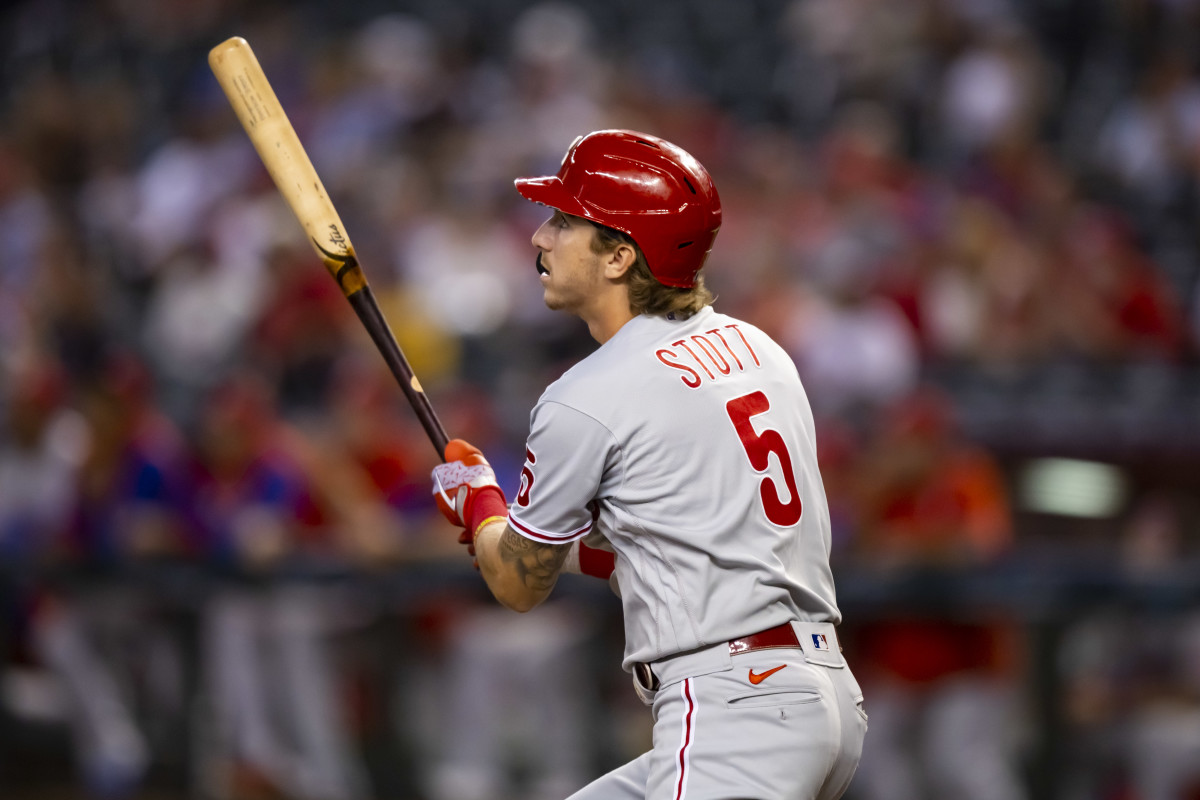
From mid-July to mid-August, Stott caught eyes around the league with his hot bat and incredible plate discipline. It was his performance the following month, however, that really proved he has what it takes to be a Major League hitter.
Tools will only get you so far in baseball. A good eye and a good bat are important, but they'll only do so much for a player if he lacks the ability to adapt and adjust on the fly.
Bryson Stott has shown tremendous growth throughout the 2022 season. The young shortstop has a bright future ahead of him, and hopefully it starts with postseason baseball in his very first season.
More From SI's Inside The Phillies:
- Phillies Star Bryce Harper Doesn't Hold Back on Thoughts About Joe Girardi
- How Mike Trout Will Join the Phillies
- Could Bryce Harper's Favorite MLB Player Join the Philadelphia Phillies Next Season?
- Why You Should Root for the Philadelphia Phillies to Lose a Few Games
- Phillies Release 2023 Regular Season Schedule
- Have the Philadelphia Phillies Found Their Centerfielder of the Future?
- Could The Phillies Soon Be Playing in Wawa Park?
- How did Philadelphia end up with Citizens Bank Park?
- How the Phillie Phanatic Came to be America's Favorite Sports Mascot
- Picking the Phillies' All-Time Single Season Lineup
Make sure to follow Inside the Phillies on Substack and Twitter!
